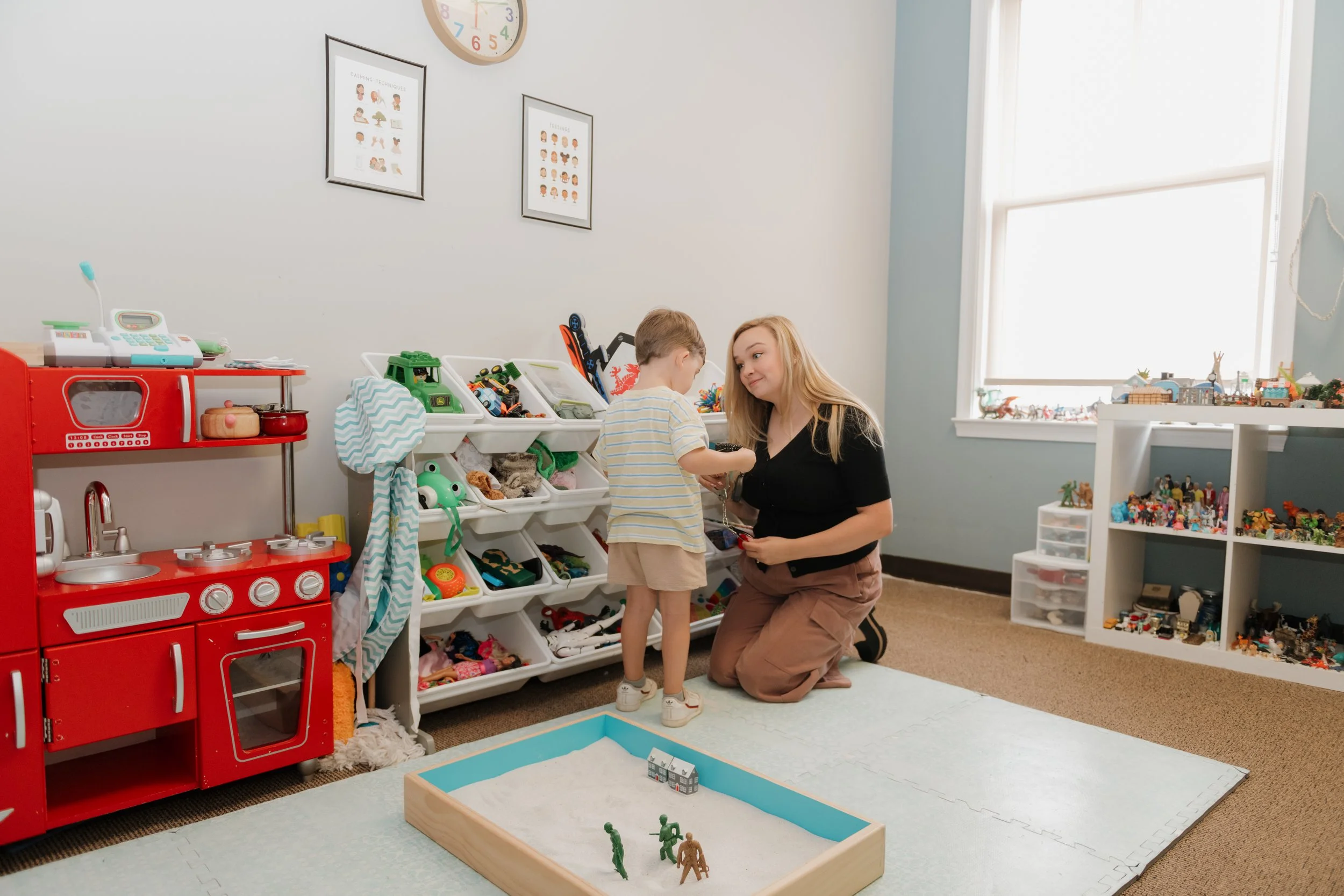How Child-Centered Play Therapy Supports Children with Separation Anxiety
By: Michelle Walker, LCSW, RPT-S
It’s developmentally appropriate for young children to feel uneasy when they’re separated from their caregivers, particularly under the age of 6, but for some kids, those worries may continue to intensify. Regardless of clinical presentation, tearful drop-offs, bedtime struggles, or constant clinginess can leave both parents and children feeling emotionally exhausted.
Separation difficulties are a normal part of early childhood development. However, approximately 4% of children experience separation distress that is intense enough to meet the criteria for Separation Anxiety Disorder (American Psychiatric Association, 2022). Research by Shear et al. (2006) indicates that children who continue to exhibit significant separation distress beyond age 6, or during their early school years, are more likely to be diagnosed with this disorder. If not addressed, separation anxiety can disrupt peer relationships, school attendance, and daily family routines.
On to the good news…Child-Centered Play Therapy (CCPT) is an effective way for children to build the confidence they need to handle separations through safe, supportive relationships (Bratton et al., 2005). In this blog, we’ll explore what separation anxiety really looks like, how it might show up in the playroom, and how CCPT can help children feel more secure and connected, even when they are apart from their primary caregivers.
What Does Separation Anxiety Disorder Really Look Like?
According to the Diagnostic and Statistical Manual of Mental Disorders, Fifth Edition, Text Revision (DSM-5-TR; APA, 2022), Separation Anxiety Disorder is defined as a developmentally inappropriate and excessive fear of being apart from a caregiver or attachment figure.
This distress can show up in many ways, while some may be more obvious, others are subtle. To meet diagnostic criteria, a child must show at least three of the following signs:
Frequent distress (i.e., crying, panic, or meltdowns) when anticipating or experiencing separation from home or a caregiver.
Ongoing worries about something bad happening to their caregiver, like an accident, illness, or disaster.
Fears that something will happen to them (like getting lost or kidnapped) that would cause permanent separation.
Refusing to go to school, a friend’s house, or other places because they don’t want to be apart.
Difficulty being alone and wanting to be near a caregiver at all times, even at home.
Resistance to sleeping away from home or without a caregiver close by.
Nightmares that center around themes of separation.
Physical complaints, such as headaches or stomachaches, are especially prevalent when separation is anticipated.
To be considered a clinical diagnosis, these symptoms must last at least four weeks in children and adolescents and cause significant distress or difficulties in school, friendships, or family routines.
While some separation anxiety is developmentally appropriate, especially in toddlers and preschoolers, it may become concerning when:
A child’s fear is intense and lasts beyond what’s typical for their age.
It causes physical symptoms like headaches or stomachaches.
It interferes with daily life (school refusal, social withdrawal).
Research shows that although healthy attachment is linked to resilience, overly intense separation fears can create a cycle of anxiety that needs extra support (Bowlby, 1988; Kerns & Brumariu, 2014).
How Separation Anxiety Shows Up in Play
Children often do not have the words to fully explain or understand their fears, yet so much is shared through their play. In CCPT, we recognize play as the child’s natural language and the importance of providing unconditional positive regard, empathy, and authentic therapeutic relationships so that the child can work through their inner conflicts. Through this inner conflict work, children will slowly begin to access their inner resources and build self-awareness. It is when the play therapist is fully present, trusting the child’s process, and listening beyond words that they begin to notice these meaningful shifts. Through reflections of struggles and strengths, the child will begin to understand themselves on a deeper level and move towards growth and development. Over time this fosters trust in self, resilience, and capability.
Trust in self is not just healing, but also the foundation for working through separation anxiety. When a child begins to feel secure in themselves, they’re better able to handle the uncertainty of being apart from their attachment figures.
Common separation anxiety play behaviors or themes might include:
Object permanence play: Burying and finding objects in the sand (or around the room), instructing therapist to find them, hide and seek with therapist, putting fences around objects or other containment play, looking for items where they’ve left them before.
Protection or rescue play: Saving characters from danger, finding ways to keep items or characters safe.
Family role-play: Acting out scenarios where a child character is left behind or lost, playing out morning or bedtime routine when a separation may be anticipated.
Separations and reunions: Such as, practicing the idea that a caregiver leaves but always comes back or characters/symbolic items being separated in some way.
Mastery: Engaging in ways they are capable and can trust themselves, particularly later in the stages of play therapy.
Whatever it is, the way you tell your story online can make all the difference.
As play therapists, we observe these play behaviors and themes without interrupting or interpreting in an adult-centered way. Instead, we create an atmosphere of safety and acceptance that helps the child explore and resolve their fears at their own pace (Landreth, 2024).
How Child-Centered Play Therapy Helps
CCPT works because it honors the child’s pace and inner wisdom, while providing a strong, secure therapeutic relationship. Research supports that non-directive play therapy is effective for anxiety, including separation anxiety (Bratton et al., 2005; Ray et al., 2015).
Key ways CCPT helps:
Safety and Trust: The therapist’s unconditional positive regard helps the child feel accepted, even when they express fears, difficulties separating, and clinginess.
Mastery Through Play: Children can “practice” separation scenarios symbolically, developing confidence and coping skills.
Secure Base: The therapist becomes a safe, predictable adult who doesn’t abandon or reject them, becoming a powerful corrective experience.
Parental Involvement: Parents are involved in the process through parent consultations, learning ways to support a secure attachment at home.
What If A Child Struggles to Separate Before Entering the Playroom?
Whether or not a child has been referred specifically for separation difficulties, many young children experience challenges separating from their caregivers at their first session. This is often due to the unknown and not knowing what to expect. In CCPT, we do not focus on “fixing” behaviors but rather on creating a relationship that allows the child to fully be themselves, where they can build the trust in themselves to explore who they are in the playroom confidently.
There are no expectations placed on a child to separate in a certain way or by a certain session. The play therapist’s role is to meet the child exactly where they are. From the very first moment, the therapist will be fully present, offering an accepting and non-judgmental attitude as they greet the child in the waiting room, come down to their level, and provide a simple, clear explanation of what to expect. This often includes a brief “tour” that shows the child where their caregiver will be while they’re in the playroom.
For children who experience separation anxiety, it is essential that the adults around them project confidence and clarity. The therapist will initially greet the child as though separation is not a concern, because in CCPT, we trust in the child’s ability to do what they are ready for. Only when the child communicates discomfort does the therapist respond with empathy and acceptance.
If a child hesitates to separate, the therapist will acknowledge and reflect the child’s feelings and then gently affirm the structure: that their time is in the playroom. Choices may be offered to return a sense of control and autonomy to the child. For example:
“You’re not sure about this place, it is new for you (Acknowledgement of the child’s experience). Do you choose to have Mom/Dad to walk with you to the playroom door, or stay here while we walk together?” (Choice)
When a child continues to resist, the therapist may determine it is most helpful for the caregiver to either walk the child to the playroom door, or even briefly accompany the child to the playroom. In those moments, your calm and confident presence is important. The therapist may ask you to sit quietly while they take the lead in interacting with the child. After a few minutes, you’ll be asked to return to the waiting area, however, this is done without sneaking away, which can create mistrust.
If your child is still not ready to separate, the therapist will not force the process. In CCPT, the relationship comes first. The therapist will continue to follow your child’s lead while holding the structure of the session. This, too, is valuable therapeutic work. Your child is telling us something important about how they experience the world, and this experience becomes part of the healing journey.
What Parents Can Do at Home
Parents can help ease separation anxiety with simple, consistent strategies:
1. Create predictable goodbye routines. Short, loving goodbyes help children trust you’ll return. Consider creating a connection handshake or a predictable and routine saying at each goodbye.
2. Use transitional objects. Provide a small item of yours (i.e. hair tie), matching bracelets made together, or a note that can remind your child of your presence.
3. Stay calm and confident. Children sense your emotions, if you project safety, they’ll feel safer. Send the message that you trust they can handle the separation. Stay present and with them even in moments of extreme distress and dysregulation sending the message that you will always be there with them.
4. Validate feelings and use encouragement: “You’re feeling scared and I know you can do hard things, I will be right here for you when you are done.”
5. Avoid sneaking away. Sneaking out can heighten anxiety; predictable departures build trust. Inform your child of where you will be when away and when you plan to return (if it is a predictable return time).
If you’re struggling, remember understanding the intention behind the need is important, ask your child’s play therapist for more tailored ideas to support your child’s unique needs.
When to Seek Extra Support
While separation anxiety is common, it may need professional support when:
Your child’s distress is extreme or prolonged.
There’s significant school refusal or social avoidance.
Family life feels controlled by the fear of separation.
Separation anxiety doesn’t have to define your family’s daily life. With the safety of the therapeutic relationship, your child can learn that goodbyes don’t mean forever, and that they are capable, secure, and deeply loved, whether you’re near or far.
References
American Psychiatric Association. (2022). Diagnostic and statistical manual of mental disorders (5th ed.). American Psychiatric Association.
Bowlby, J. (1988). A secure base: Parent-child attachment and healthy human development.
Bratton, S. C., Ray, D. C., Rhine, T., & Jones, L. (2005). The efficacy of play therapy with children: A meta-analytic review. Professional Psychology: Research and Practice, 36(4), 376–390.
Kerns, K. A., & Brumariu, L. E. (2014). Is insecure parent–child attachment a risk factor for the development of anxiety in childhood or adolescence? Child Development Perspectives, 8(1), 12–17.
Landreth, G. L. (2024). Play therapy: The art of the relationship (4th ed.). Routledge.
Ray, D. C., Armstrong, S. A., Balkin, R. S., & Jayne, K. M. (2015). Child-centered play therapy in the schools: Review and meta-analysis. Psychology in the Schools, 52(2), 107–123.
Shear, M. K., Jin, R., Ruscio, A. M., Walters, E. E., & Kessler, R. C. (2006). Prevalence and correlates of estimated DSM-IV child and adult separation anxiety disorder in the National Comorbidity Survey Replication. American Journal of Psychiatry, 163(6), 1074–1083. https://doi.org/10.1176/ajp.2006.163.6.1074



